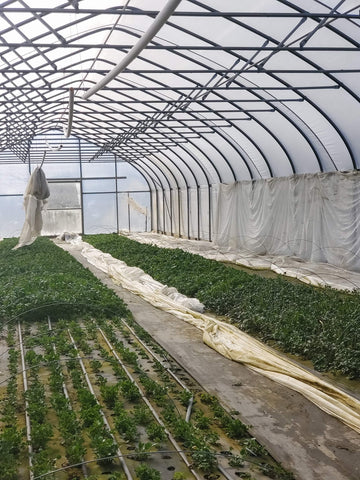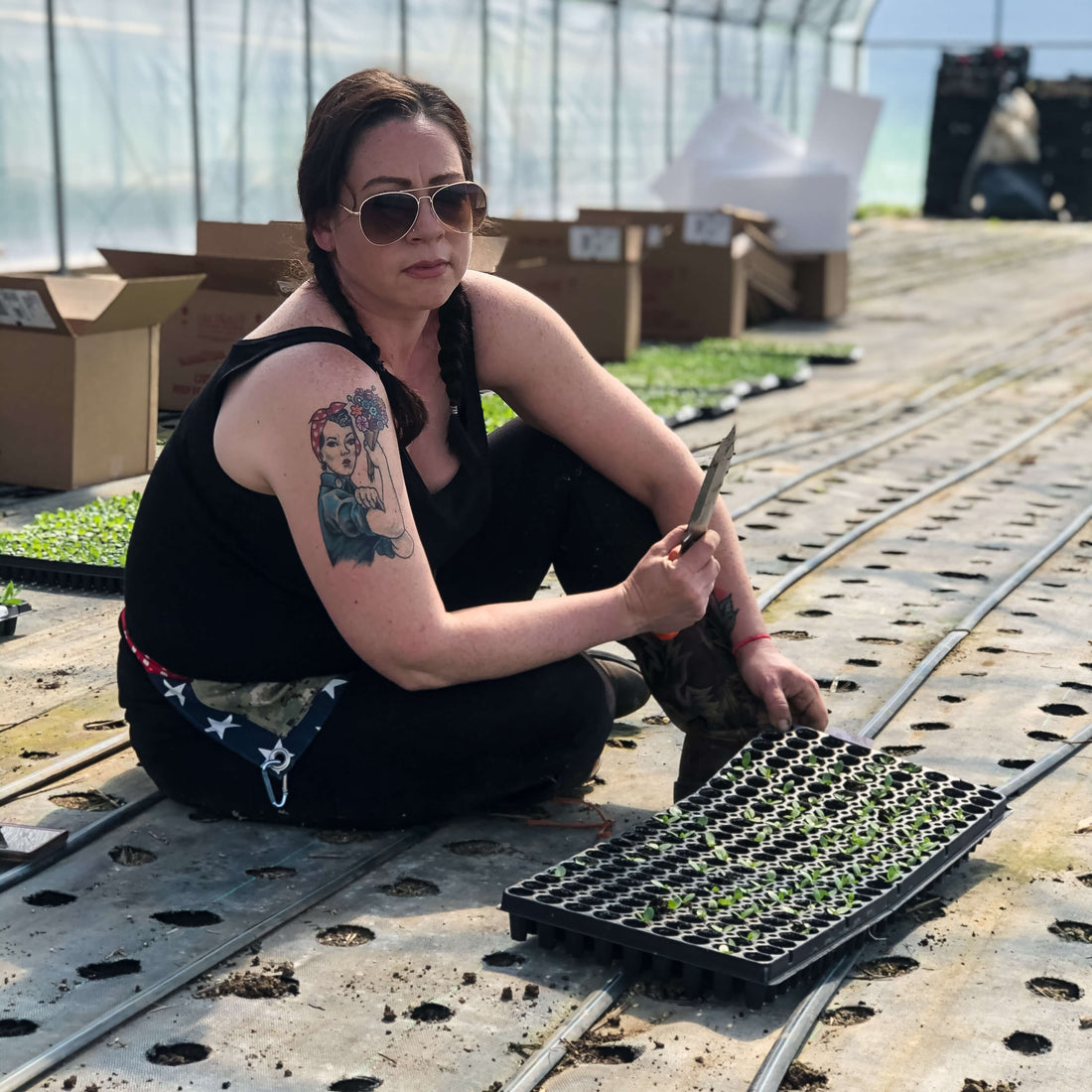Houston, we have a problem.
I knew it was going to happen. I knew the consequences of my decisions. But, I did it anyway. I set the Ranunculus crop up for failure. Ok, failure might be a strong word but I knowingly did not set them up for an easy life this season that's for sure. Sometimes we farmers do things we know is wrong because we can be just downright ornery.
The backstory: We rotate our beds in the high tunnels trying to change up where each crop lives out its season each year. This helps for many reasons; we learn where crops perform best, we don't build up any crop-specific diseases in the soil that can knock out future rotations, and we also keep all the bugs on their toes. This year, we switched the beds that grew 2020’s lisianthus crop into the 2021s ranunculus home.

I knew the lisianthus underperformed last year due to poor location, the beds were not amended before the rush of planting them. This was a residual effect of COVID because the lisianthus had been planted right when we furloughed the staff and we simply didn’t have enough hands to get the beds where they needed to be. Due to some poor drainage issues over last season, we knew the soil in these important tunnel beds was beyond compacted, depleted, and eroded down beyond subsoil levels. They turned into places only hospitable to rodents, subterranean creatures, and not the good kind like earthworms...ouch!
 |
 |
So, when fall came around and it was time to correct the soil, we were again faced with limited hands, no tools to tackle the job, (I'm so glad I ordered that damn BCS), and no budget for compost. I planned poorly, and I own it. Against my better judgment, we just yanked out the lisianthus and plopped in the ranunculus, and hoped for the best.
I rolled the dice with a VERY important spring bloomer because, for me, the ranunculus have been a sturdy little crop. They aren’t as delicate as some of the wimpy tunnel roommates (hey dahlias, talking to you here), and if they could shake off the pressures of less than ideal conditions, we would be fine. I knew what I was stepping into and it wasn’t lush soil. We also relaxed our rodent prevention and didn’t set out our winter traps to minimize colony establishment. When it's not a visible problem it's easy to overlook the prevention steps.
This doesn’t mean that growers can't produce stellar flowers in sub-par conditions, but take it from me, you're going to pay for it one way or another. Ideal conditions really just translate to efficient conditions. Plants that are naturally happy require very little, but change up the environment and they can quickly require a LOT. Maybe it’s more applications of fertilizer and treatment for pests and diseases. Maybe it means more labor to manually clean up sub-par plants to encourage and stimulate healthy growth. And, the worst-case scenario, maybe no matter what you do, you just won’t see the same amount of sellable stems.
Short-changing on the front only means you will have to invest somewhere further down the line. But, sometimes crop planning decisions have to be made to benefit the bigger picture. Now, it’s not like we just woke up one day and the whole crop was looking crazy. We knew the pickle we’d put ourselves in, so we’ve kept a close eye on the ranunculus taking notice of even the slightest changes. We knew that fungal issues would be our biggest threat and thought we were going to squeak by right up to harvest evading all of those “plant colds”. Unfortunately not the case.

 |
After the last pummeling snowfall followed by a deluge of rain, the beds sat wet and cold no matter our attempts to correct. I watched as symptoms began to surface and I quickly began to form my attack. Backpack sprayer, engage.
I'm a gentle farmer, so I picked my poison carefully and launched an attack with a dose of Cease. Cease is a biological fungicide which means it's not exactly a poison, rather it contains live spores, Bacillus Subtilis, that attack the bad guys and prevent spread. This product is OMRI listed and approved as one of the best organic resources on the commercial market for growing flowers and produce. While it's a safe and gentle product, I prefer to envision a gruesome battle where I am some kind of agricultural knight saving the princesses and bringing peace back to the kingdom. Bring on the dragons, this queen isn’t going down without a fight.
We saw an immediate improvement in the first week after spraying and were even able to squeak in a Neptune's Harvest fish emulsion foliar feed just five short days after the Cease application. The ranunculus crop now stays uncovered and the house doors are opened each day to get a gentle cross breeze moving through the plants. New growth looks great, but with all the damaged old growth still in the beds, it will be hard to totally eradicate this problem. We’re now working on manually removing all the affected foliage from every plant. This is labor-intensive and while It feels so good to work in the tunnel on nice sunny days, the added cost of labor on this one crop now means we make a little less with each bloom.
 |
 |
In conjunction with our fungal issues, we found that the sweet cozy environment we created for the ranunculus also became highly attractive to one very destructive field mouse. While covering and uncovering we began to notice mature (ready to bloom) plants that seemed to wilt overnight. Upon closer inspection, the plants had been chewed off and the holes they were planted in burrowed out for nests. I hate mice, like a LOT. Like, I will throw my children in between me and a mouse if one crossed my path. It never fails that the critters find the crops closest to bloom and it's horrifying how quickly they can take out a significant portion.
 |
 |

SO - between rodent bait stations, snap traps laced with peanut butter, and my favorite rodent torture method - 5lbs of cayenne pepper - we took that mouse out in less than 48 hours. Note: be SUPER careful when you use this. Wear your goggles and gloves, folks. It's still painful to clean up the plant remains from Mr. Mouse’s tornadic romp through the crop. Especially knowing that with a few extra bait stations and routine monitoring we could have probably prevented their little salad bar adventure altogether.

We have turned this crop around in about 10 days, and as a farmer, it’s a nice pat on the back to flex my horticulture skills, successfully combating problems. But, a lot of these nuisances could have been prevented from the beginning, and I knew that. Yes, some were just neglectful tasks like the mouse problem, while others like our fungal issues were a little more complex and forced us to make the best decision at the time understanding the domino effect on the choices we made.
 |
 |
 |
 |
The first healthy blooms are making their way into the cooler this week, and being totally on top of this crop is an accomplishment. Getting them under control couldn’t have happened soon enough as we uncover acres of crops that are now folded into the mix of daily inspections. None of this is easy to do consistently, but each flex on this farm prepares us a little bit better for the next round of prep and problem-solving. That is farming and Houston, we’re doing just fine.
- xoxo Jess


